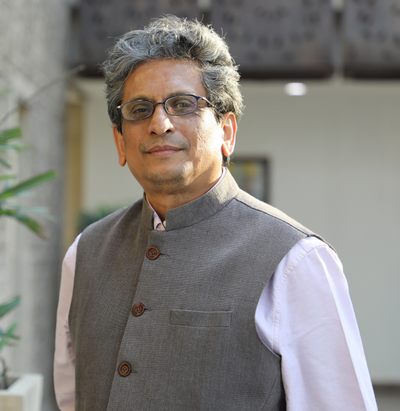Astrophysics and Cosmology (Theoretical/Observational/Computational)
Astrophysics is a branch of space science that uses the principles of physics and chemistry to understand the universe. It explores the birth, life, and death of stars, galaxies, planets, and other cosmic objects, as well as the fundamental nature of space and time.
Cosmology is a branch of physics and metaphysics dealing with the nature of the universe, the cosmos. The aim of cosmology is to apply laws of physics to the universe as a whole. Observations tell us that the universe is neither eternal nor static, and therefore it raises questions as to when and how did the universe start? What did it look like in the past? How will it evolve in the future?
Astrophysics is closely related to astronomy and cosmology, often working in collaboration to address complex questions about the universe.
Faculty Member

Head of the Department, Physics,
Sunanda and Santimay Basu Professor of Astrophysics, Ashoka University
Ph.D. Indian Institute of Science, Bengaluru

Assistant Professor of Physics, Ashoka University
Ph.D. Physical Research Laboratory, Ahmedabad

Dean, Academic Affairs and Professor of Physics, Ashoka University
Ph.D. University of Maryland

Vice-Chancellor and Professor of Physics, Ashoka University
Ph.D. in Astrophysics, University of Cambridge

Visiting Professor of Astrophysics, Ashoka University
Ph. D. Tata Institute of Fundamental Research (University of Bombay)
Focused Area of Research
Neutron star Physics: Neutron Stars harbor matter at supra-nuclear density with diverse exotic properties, many of which are yet to be fully understood. A mixture of superfluid neutrons and superconducting protons co-exist in the interior of the star, leading to complex interactions between the rotational and magnetic processes in this region. The research group at Ashoka is currently investigating the effect of such interactions on the dynamics of superfluid vortices, leading to glitches in the spin evolution of the neutron star.
Polarised X-ray and Gamma-ray emission: Several modern space-based observatories are currently detecting polarised radiation in X-ray and gamma-ray bands from a variety of cosmic sources. Research at Ashoka is aiming to understand the origin of such polarised emission while also being involved in carrying out related observations and planning future experiments.
Cosmology: Cosmic Inflation, Dark Matter, Dark Energy, Primordial Gravitational Waves, Primordial Black Holes and Primordial Magnetic Fields: Cosmology is one of the most active branches of Physics in the present era with new state-of-the art data coming in every year from various observations. On the other hand, there are many aspects of modern cosmology which are not yet well understood, such as the nature of Dark Matter and Dark Energy as well as what drives Cosmic Inflation and how. Theoretically, Primordial Gravitational Waves and Primordial Black Holes (generated during the very early epochs of the Universe) can help resolve some of these big questions. At Ashoka, Suratna Das is looking into many different aspects of Cosmic Inflation, Dark Energy and Dark Matter
Cosmic Magnetic fields: The universe is magnetized, from planets and stars to galaxies and galaxy clusters, and even possibly the void regions of the intergalactic medium. Magnetic fields are born in cosmic batteries or the early universe. In their turbulent youth, they can be rapidly amplified by random stretching on scales of order or smaller than the turbulent eddy scale. The ordering of magnetic fields to system scales occurs in mature, rotating, stratified systems due to breaking of parity. Fields in voids will need an early universe origin. Open questions in these processes are being studied.
For a complete list of publications, please click here
Facilities Available
Access to national and international astronomical observatories; Computing facilities at Ashoka and at IUCAA, Pune.
National/International Collaborations
- Ashoka faculty are deeply involved in current and future Indian space missions such as AstroSat and Daksha, as well as International mega projects including the Square Kilometre Array radio telescope and the Laser Interferometric Gravitational Wave Observatories. Ongoing research involves active collaboration with numerous institutions across the world.
- Suratna Das has active and ongoing collaborations with Prof. Rudnei O. Ramos (Professor, Universidade do Estado do Rio de Janeiro, Brazil), Prof. Varun Sahni (Emeritus Professor, IUCAA, Pune), Dr. Swagat Mishra (University of Nottingham, UK)





